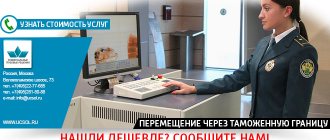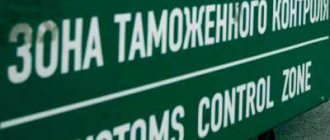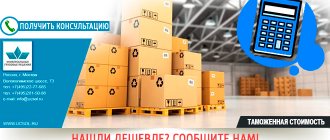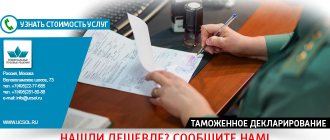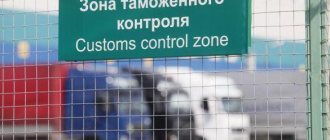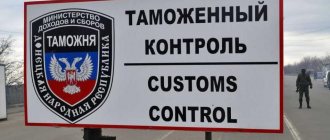1. Violation of the procedure for the arrival of goods and (or) vehicles of international transportation into the customs territory of the Customs Union by importing them in addition to the places of movement of goods across the customs border of the Customs Union or other places established by the legislation of the member states of the Customs Union or outside the working hours of customs authorities or taking actions , directly aimed at the actual crossing of the customs border of the Customs Union by goods and (or) vehicles of international transportation upon their departure from the customs territory of the Customs Union in addition to the places of movement of goods across the customs border of the Customs Union or other places established by the legislation of the member states of the Customs Union or outside of working hours customs authorities or without the permission of the customs authority, -
entails the imposition of an administrative fine on citizens and legal entities in the amount of one-half to three times the value of goods and (or) vehicles that were the subjects of an administrative offense, with or without their confiscation, or confiscation of the items of an administrative offense; for officials - from ten thousand to twenty thousand rubles.
2. Concealing goods from customs control by using hiding places or other methods that make it difficult to detect goods, or by making some goods look like others when moving them across the customs border of the Customs Union -
entails the imposition of an administrative fine on citizens and legal entities in the amount of one-half to three times the value of the goods that were the subject of an administrative offense, with or without their confiscation and the confiscation of goods and (or) vehicles that were instruments of committing an administrative offense, or confiscation of items administrative offense; for officials - from ten thousand to twenty thousand rubles.
3. Reporting to the customs authority inaccurate information about the number of packages, their markings, name, gross weight and (or) volume of goods upon arrival to the customs territory of the Customs Union, departure from the customs territory of the Customs Union or placement of goods under the customs procedure of the customs transit or to a temporary storage warehouse by presenting invalid documents or using for these purposes a counterfeit means of identification or a genuine means of identification relating to other goods and (or) vehicles -
entails a warning or the imposition of an administrative fine on citizens in the amount of one thousand to two thousand five hundred rubles with or without confiscation of goods that were the subjects of an administrative offense, or confiscation of the items of an administrative offense; for officials - from five thousand to ten thousand rubles; for legal entities - from fifty thousand to one hundred thousand rubles with or without confiscation of goods that were the subjects of an administrative offense, or confiscation of the subjects of an administrative offense.
4. Part 4 lost force on July 4, 2021 on the basis of Federal Law No. 207-FZ of June 23, 2016.
Notes:
1. For administrative offenses provided for in this chapter, persons carrying out entrepreneurial activities without forming a legal entity bear administrative liability as legal entities.
2. For the purposes of applying this chapter, invalid documents mean counterfeit documents, documents obtained illegally, documents containing false information, documents relating to other goods and (or) vehicles, and other documents that do not have legal force.
Digital library
Jurisprudence / Customs law / 1.6 Basic principles of movement of goods and vehicles across the customs border
The basic principles of the movement of goods and vehicles across the customs border are fundamental legal requirements, on the basis of compliance with which all participants in customs legal relations should carry out legal regulation of the procedure for moving goods and vehicles across the customs border of the Russian Federation (Chapter 2 of the TMK of the Russian Federation).
These principles include:
· the principle of equal rights of all persons to import and export of goods (including currency and currency valuables) and vehicles;
· the principle of compliance with prohibitions and restrictions when moving goods across the customs border;
· the principle of mandatory customs clearance and customs control;
· the principle of regulating the procedure for using and disposing of goods and vehicles transported across the customs border;
· the principle of distribution of responsibilities for performing customs operations for the release of goods;
· the principle of guaranteeing the proper fulfillment of duties established by the Customs Code of the Russian Federation.
The essence of the principle of equal rights of all persons to import and export of goods (including currency and currency valuables) and vehicles
is that all legal entities and individuals have the right to move goods (including currency and currency valuables) and vehicles across the customs border on an equal basis. This right corresponds to the norms of the Constitution, which secured for everyone (regardless of Russian citizenship) the opportunity to freely travel outside Russia, and Russian citizens to return to it freely (Article 27 of the Constitution of the Russian Federation), as well as the right of everyone to freely use their abilities and property for business activities (Article 34 of the Constitution of the Russian Federation), including in the foreign economic sphere.
Legal equality of rights to move goods and vehicles is recognized for all persons, regardless of whether they are the owners of goods, their buyers, holders, or act in another capacity sufficient to perform actions with goods provided for by law on their own behalf.
No one can be deprived of the right or limited in the right to import into and export from Russia goods and vehicles, except for cases provided for by the Customs Code of the Russian Federation and other acts of Russian legislation.
Goods and vehicles are moved across the customs border in the manner established by the Customs Code of the Russian Federation. The procedure for moving the currency of the Russian Federation, securities denominated in the currency of the Russian Federation, foreign currency and other currency values across the customs border is regulated by the legislation of the Russian Federation on currency regulation and currency control.
The essence of the principle of compliance with prohibitions and restrictions when moving goods across the customs border
is that in some cases the state can
establish a ban or restrictions on the free movement of certain types of goods across the customs border, based on considerations:
· state security;
· protection of public order, morality of the population, human life and health;
· protection of animals and plants;
· environmental protection;
· protection of the artistic, historical and archaeological heritage of the peoples of Russia and foreign countries;
· protection of property rights (including intellectual);
· protecting the interests of Russian consumers of imported and exported goods, fulfilling the international obligations of the Russian Federation;
· protection of the economic basis of sovereignty;
· as a response to discriminatory or other actions infringing on the interests of Russian individuals by foreign states;
· other fairly important reasons.
Goods prohibited for import into the territory of Russia are subject to immediate export from its customs territory, unless otherwise provided by the Customs Code of the Russian Federation or other federal laws. Export of these goods is carried out by the carrier. If export is impossible or immediate export is not carried out, these goods are subject to placement in temporary storage warehouses or in places that are customs control zones.
The maximum period for temporary storage of such goods is three days, unless a different period is provided for by other federal laws in relation to certain types of goods. The disposal of these goods after this period is carried out in accordance with Chapter 41 of the TMK of the Russian Federation.
Goods restricted for import into the customs territory of the Russian Federation are allowed for import (and in cases provided for by the Customs Coke of the Russian Federation, are released by customs authorities) subject to the requirements and conditions established by international treaties of the Russian Federation or the legislation of the Russian Federation. Goods prohibited for export are not subject to actual export from the customs territory of the Russian Federation.
Goods restricted for export from the customs territory of the Russian Federation are allowed for export subject to the requirements and conditions established by international treaties of the Russian Federation or the legislation of the Russian Federation.
Expenses incurred by persons in connection with non-compliance with prohibitions and restrictions on the import of goods into the customs territory of the Russian Federation or their export from this territory are not reimbursed by customs authorities.
The essence of the principle of mandatory customs clearance and customs control
is that all goods and vehicles transported across the customs border of Russia are subject to customs clearance and customs control in the manner and under the conditions provided for by the Customs Code of the Russian Federation.
When carrying out customs clearance and customs control, customs authorities and their officials do not have the right to establish requirements and restrictions not provided for by acts of customs legislation or other legal acts of the Russian Federation.
The requirements of customs authorities presented during customs clearance and customs control cannot serve as an obstacle to the movement of goods and vehicles across the customs border and the implementation of activities in the field of customs affairs to a greater extent than is minimally necessary to ensure compliance with acts of customs legislation.
The essence of the principle of regulation of the procedure for use and disposal of goods and vehicles transported across the customs border
is that no one has the right to use and dispose of goods and vehicles before their release except in the manner and under the conditions provided for by the Customs Code of the Russian Federation.
After the release of goods and vehicles, their use and disposal are carried out in accordance with the declared customs regime.
In accordance with the principle of distribution of responsibilities for performing customs operations for the release of goods
The obligation to carry out customs operations for the release of goods, unless otherwise established by this TMK of the Russian Federation, is borne by:
· if the movement of goods across the customs border is carried out in accordance with a foreign economic transaction concluded by a Russian person - the Russian person who entered into such a foreign economic transaction or on behalf of or on whose behalf this transaction was concluded;
· if the movement of goods across the customs border is carried out without concluding a foreign economic transaction by a Russian person:
- a person who has the right of ownership and (or) the right to use goods in the customs territory of the Russian Federation;
- other persons acting in a capacity sufficient in accordance with the civil legislation of the Russian Federation and (or) the Customs Code of the Russian Federation to perform legally significant actions on their own behalf with goods under customs control.
The essence of the principle of guaranteeing the proper fulfillment of duties established by the Customs Code of the Russian Federation
, is that in cases provided for by the TMK of the Russian Federation and other legal acts of the Russian Federation, customs authorities have the right, in relation to goods, to require persons to provide guarantees for the proper fulfillment of their duties established by the TMK of the Russian Federation, including in the form of security for the payment of customs duties in accordance with the provisions Chapter 31 of TMK RF.
The movement of goods and vehicles across the customs border in non-compliance with the principles discussed is unlawful and entails liability in accordance with current Russian legislation.
What you need to know about the rules for importing goods for personal use from abroad Printable version
The above carriage rules apply only to goods for personal use.
Goods for personal use - goods intended for personal, family, household and other, not related to business, needs of individuals, transported across the customs border of the Eurasian Economic Union (EAEU) in accompanied or unaccompanied luggage by sending in international mail or in a different way.
In relation to goods transported across the customs border of the EAEU by individuals that are not classified as goods for personal use and imported for the purpose of using them in business activities , the above transportation standards do not apply.
Such goods are subject to movement across the customs border of the EAEU in accordance with the generally established procedure.
The classification of goods transported across the customs border of the EAEU as goods for personal use is carried out by the customs authority using a risk management system based on:
- statements of an individual about goods transported across the customs border of the EAEU orally or in writing using a passenger customs declaration;
- nature and quantity of goods;
- the frequency of an individual crossing the customs border of the EAEU and (or) the movement of goods across the customs border of the EAEU by this individual or to his address.
The list of certain types of motor vehicles and motor vehicles and trailers for motor vehicles and motor vehicles, which are vehicles for personal use, can be found here (Decision of the Board of the Eurasian Economic Commission dated June 30, 2017 No. 74).
Regardless of the above criteria, the following goods do not qualify as goods for personal use:
1) goods in respect of which an individual carries out customs declaration for placement under customs procedures, with the exception of the customs procedure of customs transit;
2) categories of goods determined by the Decision of the Council of the Eurasian Economic Commission (Appendix No. 6 to the Decision of the Council of the Eurasian Economic Commission of December 20, 2021 No. 107).
During their stay in the customs territory of the Union, foreign individuals may import used goods for personal use without paying customs duties and taxes.
Customs declaration of goods for personal use is carried out using a passenger customs declaration. At the same time, the acceptance and registration of the passenger customs declaration is carried out by the customs authority free of charge.
The essence and basic principles of the movement of goods and vehicles across the customs border
movement of goods and (or) vehicles across the customs border of the Russian Federation means the implementation of actions for the import into the customs territory of the Russian Federation or export from this territory of goods and (or) vehicles in any way, including sending in international mail, transportation through main pipelines and lines power transmission
Participants in foreign economic activity should be aware that from the moment a product acquires the status of a transportable right of use and its disposal are limited by the relevant requirements of customs legislation.
When importing goods (vehicles) into the customs territory of the Russian Federation, the movement begins with the actual crossing of the customs border of the Russian Federation and ends with the release of goods (the adoption by the customs authority of a decision on the possibility of using the selected customs procedure or a special customs procedure). Accordingly, goods in the process of customs clearance are considered as being moved across the customs border of the Russian Federation.
When exporting goods (vehicles) from the customs territory of the Russian Federation, the movement begins from the moment of filing a customs declaration or performing other actions considered as directly aimed at exporting goods (vehicles) outside the customs territory of the Russian Federation, and ends with the actual crossing of the goods (vehicles) into the customs borders of the Russian Federation (export of goods).
Therefore, a movement is characterized by a beginning, a period of time and an end, i.e. we can talk about goods (vehicles) transported across the customs border of the Russian Federation and goods transported (released by customs authorities after import or crossing the customs border upon export).
When moving goods across the customs border, the obligation to pay customs duties, taxes, and fees arises:
1) when importing goods - from the moment of crossing the customs border;
2) when exporting goods - from the moment of filing a customs declaration or taking actions aimed at exporting goods from the customs territory of the Russian Federation.
For the purposes of customs legislation, goods are any movable property moved across the customs border, as well as vehicles classified as immovable things moved across the customs border.
In customs terms, goods -
this is a subject of customs clearance and customs control; subject to customs duties and taxes.
The main feature of goods is movement across the customs border of the Russian Federation.
It should be noted that certain objects of civil rights, such as, for example, results of intellectual activity, including exclusive rights to them (intellectual property), are not covered by the concept of goods used for customs purposes. At the same time, when moving across the customs border of goods containing objects of intellectual property, the latter are also subject to customs control, customs clearance and accounting when calculating the tax base for the collection of customs duties and taxes. The Customs Code of the Customs Union contains a separate section that defines the features of movement across the customs border and the performance of customs operations in relation to certain categories of goods, for example goods sent in international mail or vehicles during international transport, as well as goods transported by certain categories of foreign persons (diplomatic representative offices, consular offices, etc.).
An important customs and legal characteristic of goods is their division into Russian and foreign. The belonging of a product to Russian and foreign is used for the purposes of application or non-application (within the framework of individual customs regimes) of tariff and non-tariff regulation measures, as well as prohibitions and restrictions of a non-economic nature. For example, goods that at the time of export had the status of Russian goods can be placed under the customs re-import procedure. In accordance with the Customs Code of the Customs Union, the use of the re-import procedure provides for exemption from customs duties and taxes and, in addition, the non-application of prohibitions and restrictions of an economic nature to goods. Only foreign goods with full conditional exemption from customs duties and taxes can be placed under the customs procedure of processing in the customs territory.
In general, Russian goods are goods that are in free circulation in the customs territory of the Russian Federation, i.e. free from restrictions on property rights from customs legislation.
The criteria for goods to acquire Russian status may be:
o full production of goods on the territory of the Russian Federation;
o release of goods for free circulation on the territory of the Russian Federation (i.e., goods originally produced abroad, after importation into the Russian Federation and payment of customs duties in compliance with all prohibitions and restrictions, acquire Russian status);
o production in the Russian Federation of goods from goods wholly produced or released for free circulation in the customs territory of the Russian Federation.
It should be noted that when Russian goods are exported outside the customs territory of the Russian Federation, they lose their Russian status and are considered foreign.
All goods that do not meet the Russian criteria are foreign .
Unlike Russian goods, foreign goods are always located in the customs territory of the Russian Federation under customs control. The presence of foreign goods under customs control provides for their use and disposal only in the manner and under certain conditions. These restrictions may be due, for example, to the requirements of customs procedures for customs transit, temporary storage of goods, etc.
Not applicable
goods include vehicles used for international transport of passengers and goods.
However, if the purpose of moving a vehicle is its purchase and sale, exchange (barter), donation, ensuring the normal operation of representative offices of foreign companies located in the Russian Federation, then it falls under the concept of goods.
Customs operations are individual actions in relation to goods and vehicles performed by persons (including participants in foreign trade activities) and customs authorities in relation to imported, exported or transit goods, including during their customs clearance, in order to ensure compliance with customs legislation.
Customs operations are equally applied regardless of the countries of origin, departure, and destination of goods. These include payment of customs duties, implementation of customs control, release of goods by customs authorities.
Customs formalities are a set of provisions that provide for the procedure for carrying out customs operations and determine the status of goods and vehicles for customs purposes. These include, for example, internal customs transit, temporary storage, the procedure for selecting and using customs procedures. Customs formalities appear and begin to operate from the moment the goods cross the customs border and include operations preceding customs clearance and declaration, such as inspection of cargo and vehicles, their identification, and customs control.
At their core, customs operations and formalities are those powers that must be exercised by subjects of foreign trade activities or other interested parties and customs authorities when moving goods and vehicles across the customs border of the Russian Federation.
Both legal entities and individuals can carry out actions to import or export goods.
Russian entities are legal entities located in the Russian Federation, created in accordance with the legislation of the Russian Federation, and (or) individuals registered as an individual entrepreneur and permanently residing in the Russian Federation.
Foreign persons are persons who are not Russian persons.
When importing goods into the Russian Federation from the territory of a state that is not a member of the Customs Union, the carrier is obliged to:
1) deliver the goods to the place of arrival;
2) present the goods to the customs authority;
3) submit to the customs authority documents and information, the list of which is established by Art. 159 TK TS;
4) submit certificates, permits, licenses or other documents confirming compliance with established prohibitions and restrictions, if in accordance with the customs legislation of the Customs Union or the legislation of the Russian Federation such documents are subject to submission to the customs authority at the place of arrival;
5) carry out customs operations related to the placement of goods for temporary storage or their customs declaration in accordance with the customs procedure, in accordance with the customs legislation of the Customs Union and the legislation of the Russian Federation on customs affairs.
The carrier, customs representative or other interested party has the right to provide the customs authority with preliminary information about the goods before their actual arrival in the customs territory of the Russian Federation, including in the form of electronic documents. At the points of arrival, unloading and reloading of goods can be carried out, and it is also allowed to carry out customs operations related to the temporary storage of goods, their customs declaration and release in accordance with the declared customs procedure. However, these operations must be carried out within 3 hours after the goods are presented to the customs authority.
When goods depart from the Russian Federation, the carrier is obliged to submit to the customs authority the documents and information provided for in Art. 159 and 163 TC TC. On behalf of the carrier, documents and information may be submitted by any other person acting on behalf of the carrier. The export of goods from the Russian Federation is permitted after their customs declaration and the completion of other operations necessary to place the goods under the customs procedure and release the goods.
Regulation of the procedure for the movement of goods and vehicles across the customs border is carried out on the basis of compliance by participants in foreign trade activities, individuals moving goods not for business purposes, customs authorities, and subjects of the near-customs infrastructure with fundamental requirements, called the basic principles of movement of goods and vehicles.
These principles include:
o equal right of all persons to import and export of goods and vehicles;
o prohibitions and restrictions when moving goods across the customs border;
o mandatory customs clearance and customs control;
o the principle of certainty of the place and time of crossing the customs border;
o use and disposal of goods and vehicles;
o providing guarantees for the proper performance of duties.
It is necessary to consider the essence and legal framework for the application in customs of the above principles of movement of goods and vehicles across the customs border of the Russian Federation.
The movement of goods across the customs border of the Russian Federation by individuals is carried out in accordance with the general principles of movement, but has its own distinctive features. The most important feature is that customs clearance of goods transported by individuals not for production or other commercial activities is carried out in a simplified manner.
The main purpose of simplified procedures
is to facilitate and speed up the procedure for passing customs formalities by individuals moving goods for personal use.
The principle of freedom and equality of rights of persons to move goods and vehicles across the customs border of the Russian Federation is that all participants in foreign economic activity and individuals moving goods not for business purposes have the right to move goods and vehicles across the customs border of the Russian Federation on an equal basis . As a rule, none of the participants in foreign economic activity can be deprived of this right or limited in it. However, the implementation of this right is impossible without compliance with the established rules and procedures for moving goods (vehicles) across the customs border.
Under the import of goods and vehicles
to the customs territory of the Russian Federation understand:
1) actual crossing of the customs border;
2) subsequent registration.
Removal of goods and vehicles
from the customs territory of the Russian Federation represents the submission of a customs declaration or the performance of other actions directly aimed at the export of these items, as well as all subsequent actions before they actually cross the customs border.
The establishment of the principle of equality when moving goods and vehicles across the customs border is based on the norms of the Constitution of the Russian Federation, which in Art. 27 enshrines the right of every person to freely travel outside the Russian Federation and freely return to the Russian Federation.
In addition, Art. 34 of the Constitution of the Russian Federation guarantees every person the right to freely use their property for business and other activities not prohibited by law. At the same time, the procedure for moving its national currency and currency values across the customs border of the Russian Federation is regulated by the Law on Currency Regulation and Currency Control (as amended by Federal Law No. 409-FZ of December 6, 2012, which entered into force on December 5, 2012. ).
Let us consider the principle of mandatory compliance with prohibitions and restrictions when moving goods across the customs border of the Russian Federation.
Prohibitions and restrictions can be provided both in accordance with international treaties of the Russian Federation and with the internal legislation of the Russian Federation. Current prohibitions and restrictions apply equally to all participants in foreign trade activities and individuals moving goods not for business purposes across the customs border. At the same time, specific prohibitions and restrictions are established only in relation to certain types of goods, including goods originating from certain countries. If goods prohibited for import were nevertheless imported into the Russian Federation, then such goods are subject to immediate export or are placed in a temporary storage warehouse or other places that are customs control zones for the purpose of export outside the Russian Federation within three days.
Prohibitions and restrictions on the movement of goods across the border (non-tariff regulation, prohibitions and restrictions of a non-economic nature) are established by the legislation of the Russian Federation on state regulation of foreign trade activities and are implemented through the use of non-tariff regulation measures.
In accordance with the Law on the Fundamentals of State Regulation of Foreign Trade Activities under Non-Tariff Regulation
refers to the method of state regulation of foreign trade in goods, carried out by introducing:
a) quantitative restrictions (quotas);
b) other prohibitions and restrictions of an economic nature (licensing, application of special protective, anti-dumping and countervailing measures when importing goods).
Participants in foreign trade activities must take into account that prohibitions and restrictions of a non-economic nature are applied regardless
from the declared customs procedure. The application of prohibitions and restrictions of an economic nature depends on the chosen customs procedure. These prohibitions are applied within the framework of such customs procedures as release for domestic consumption, export, processing in the customs territory, processing for domestic consumption. If goods are declared under other customs procedures, then prohibitions and restrictions of an economic nature do not apply to them.
Prohibitions and restrictions on the movement of goods and vehicles across the customs border are established in various federal laws. Law on Currency Regulation and Currency Control (as amended on December 6, 2011), Law on Customs Tariffs (as amended by Federal Law No. 239-F3 dated December 3, 2012, which entered into force on January 1, 2013) ; Federal Law “On Technical Regulation” dated December 27, 2002 No. 184-FZ (as amended by Federal Law dated July 28, 2012 No. 133-F3), etc.
The grounds for prohibiting import or export operations are:
o the need to maintain economic security and defend national interests;
o the need to protect public order, public morality, ethics, life and health of the population, flora and fauna, and the natural environment as a whole;
o protection of cultural values, artistic, historical and archaeological heritage of the peoples of the Russian Federation;
o protection of the external financial situation and maintenance of the balance of payments of the Russian Federation, as well as property rights, including intellectual property.
Along with a complete ban on the import into and export from the Russian Federation of goods and vehicles, various restrictions can be applied: in trade in certain goods (commodity restrictions); with individual countries or groups of countries (geographical restrictions); restrictions that apply for a certain period of time (time restrictions).
The President of the Russian Federation establishes bans and restrictions on foreign trade in goods, services and intellectual property for the purpose of Russia's participation in international sanctions, determines the procedure for the export of precious metals and precious stones, introducing appropriate bans and restrictions.
In exceptional cases, the Government of the Russian Federation may establish temporary restrictions or bans on the export of food or other goods that are essential for the domestic market of the Russian Federation, restrictions on the import of agricultural goods or aquatic biological resources in accordance with a determined list. In this case, we can talk about a permitting system in the form of licensing as part of restrictions on the import (export) of goods within quotas. When deciding to introduce a quota, the Government of the Russian Federation determines the method for distributing the quota and, in appropriate cases, establishes the procedure for conducting a competition or auction. Participants in foreign economic activity must take into account that the distribution of quotas is based on their equality in relation to receiving a quota and their non-discrimination on the basis of ownership, place of registration or market position.
In addition, restrictions in the system of movement of goods across the customs border are carried out through special certification of products, when the presence of accompanying veterinary, phytosanitary and other certificates is required.
Particularly noteworthy is the principle of mandatory customs clearance and customs control . Its essence boils down to the fact that all goods transported across the customs border are subject to customs clearance and customs control.
Under customs clearance
refers to a set of measures in relation to goods and vehicles moved across the customs border, and documentation of all actions taken (primarily placing goods and vehicles under a certain customs procedure). Customs clearance of goods is used regardless of the country of origin of the goods and its intended purpose, but at the same time, the process is differentiated depending on the type and properties of the goods, the type of transport that ensures their movement across the customs border, and the status of potential declarants.
Under customs control
is understood as a set of measures carried out by customs authorities to ensure compliance with customs legislation. As one of the instruments of customs policy, customs control makes it possible to establish the status of goods and vehicles for customs purposes. When carrying out customs control, customs authorities proceed from the principle of selectivity and sufficiency. Goods under customs control are recognized as Russian goods when they are exported before they actually cross the customs border of the Russian Federation, foreign goods imported into the territory of the Russian Federation before they are released for free circulation, before they actually cross the border or until they are destroyed.
In accordance with the principle of certainty of place and time, crossing the customs border by goods and vehicles is allowed only in specific places established by state customs authorities during their working hours. For certain types of export-import operations, specific checkpoints and their movement across the customs border can be established.
Let's consider the principle of use and disposal of goods and vehicles . As is known, the use and disposal of property, along with ownership, are the powers of the owner. Use
represents the legal possibility of using property by extracting useful properties from it and consuming it;
disposal
- the possibility of changing the ownership, condition or purpose of property.
The presence or absence of prohibitions and restrictions on the use and disposal of goods and vehicles determines the status of goods and vehicles for customs purposes.
There are two stages in the regime of use and disposal of goods and vehicles - before and after the release of goods and vehicles.
Under the release of goods
refers to the action of customs authorities, which consists in allowing interested parties to use and (or) dispose of goods in accordance with the chosen customs procedure.
Providing guarantees for the proper implementation of duties is one of the basic principles of moving goods across the customs border. According to this principle, customs authorities, in cases provided for by law, have the right to require interested parties to provide guarantees for the proper performance of their duties.
One of the guarantees is the provision of payment of customs duties. Security for the payment of customs duties as a guarantee of proper performance of duties is provided in case of deferment or installment payment, conditional release of goods, transportation or storage of foreign goods, as well as when carrying out activities in the field of customs affairs. Methods of ensuring the payment of customs duties include pledge of goods, bank guarantee, cash deposit, and surety.
As one of the guarantees, the CU Customs Code also names the provision of an obligation to re-export temporarily imported goods. The peculiarity of this guarantee is that it can only take place when a permit is issued to place goods under a customs procedure, the content of which provides for complete or partial exemption from customs duties and taxes or a refund of amounts paid or non-application of prohibitions and restrictions of an economic nature.
The list of guarantees for the proper performance of duties is not exhaustive and is supplemented by other legal acts.
The main problem in the regulation of customs legal relations
The main problem of the customs business can be described as the presence of an obvious polarity between the interests of the state and the participant in foreign trade activities. Let us explain this as follows. It was already mentioned above that the origin of international trade was based on the need for mutually beneficial exchange of labor products (goods). The possibility of producing the latter depended on many factors concentrated within the borders of a particular state. The fundamental factor has always been the availability of natural and/or fossil resources. Thus, states in whose territory forests grew, from ancient times had rich reserves of furs, wood, berries and mushrooms, countries with mountainous terrain were famous for sheep’s wool, grapes, honey, and coastal countries were famous for seafood (fish, corals, pearls). The presence of these goods determined the development of crafts characteristic of the area associated with the processing of raw materials.
From the course of economics we know that the lowest price for a product is where the highest concentration of this product is, i.e. at the place of its production (“price from the manufacturer”). As you move away from the place of production, the quantity of a product decreases and a proportion begins to apply: the farther from the place of production of a product, the higher its price.
Considering this circumstance (since ancient times), the greatest profits were received by those merchants (negotiators, entrepreneurs, businessmen) who presented the rarest goods on the market - “overseas curiosities.”
Theoretically, the profit of a businessman engaged in the resale of goods can be calculated using a simple formula: the amount of money received by the entrepreneur when selling (selling) the goods minus the amount paid by the entrepreneur when purchasing the goods.
However, in practice, the “ideal profit” calculated using the presented method loses its significant part due to the presence of two factors:
- overhead costs associated with transportation, transshipment, reloading, repackaging, insurance, natural loss (or partial damage), storage of goods and other similar expenses incurred by the entrepreneur until its full sale;
- taxes established by the state (customs taxes and fees, income taxes, other taxes and fees) that an entrepreneur is required to pay in accordance with the current tax system.
Taking these factors into account, the “ideal profit” of a foreign trade participant is divided into components, which can be shown using the following diagram (Fig. 4.1).
The state is primarily interested in filling the budget, i.e. increasing the volume of the dark part of the diagram (Fig. 4.1). According to the logic of the leadership of any state, only the presence of an extensive, deficit-free budget ensures the security and stability of the state, while the well-being of each individual citizen is secondary, i.e. The more taxes collected, the ultimately better for all citizens of the state.
Rice. 4.1. Components of the “ideal profit” of a foreign trade participant
1 The data for constructing the diagram is selected conditionally. Their real value directly depends on the experience of the entrepreneur, the rates of customs duties and other taxes, the country of origin of the goods and many other points.
It is clear that a thoughtless increase in the tax burden cools the interest of entrepreneurs in work or leads to their ruin, which ultimately also negatively affects the budget.
Taking this into account, the state’s budget strategy is based on the following principles:
- constant search for an optimal (acceptable by both parties) taxation system (including when applying customs tariff regulation measures);
- strict supervision over the payment of established taxes.
The following narrative reflects how these principles are implemented in customs affairs.
Obviously, the entrepreneur is primarily interested in increasing his personal well-being, which directly depends on increasing real profits, so he makes every effort to minimize overhead costs and expenses that the state obliges him to pay in the form of taxes. According to the logic of the entrepreneur, the lower the taxes, the more rich people there are and the fewer problems the state has in developing and organizing the financing of various social programs.


